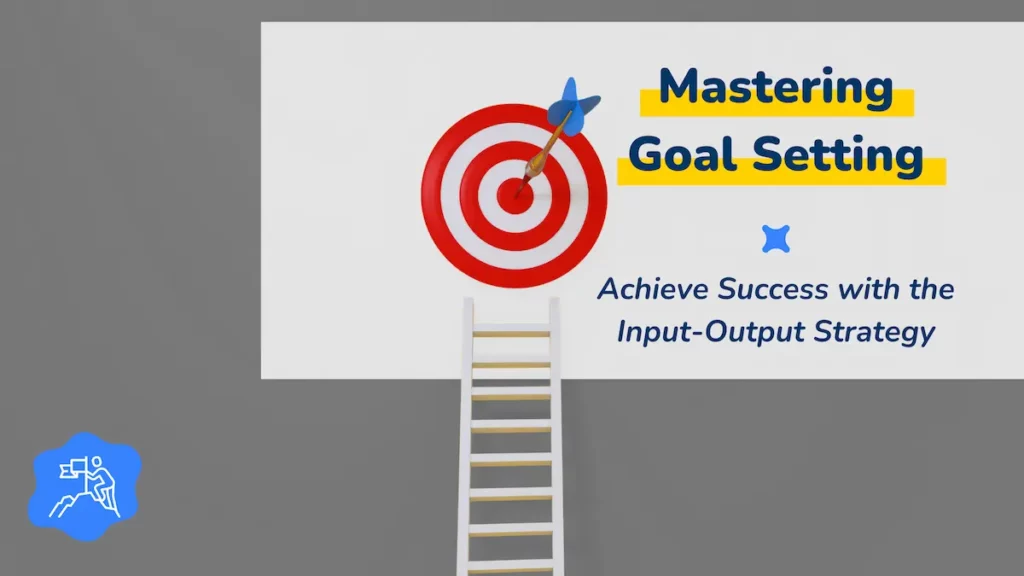Mastering goal setting is an art. Many people have experienced the frustration of setting SMART goals only to find themselves struggling to follow through. Despite the clear structure and proven effectiveness of SMART goals, maintaining the motivation and consistency required to achieve them can be challenging. If you’ve ever set a SMART goal and failed to see it through, you’re not alone. This article will help you understand why this happens and introduce you to the Input-Output Strategy, a technique designed to help you master your goal-setting efforts and ensure consistent progress.
In this article, we will explore how the Input-Output Strategy can be used in conjunction with traditional goal-setting principles. This dual approach will equip you with the tools to set realistic goals and maintain the motivation needed to accomplish them, even in the face of challenges.
Traditional Goal Setting: A Foundation for Success
Understanding SMART Goals
One of the most widely recognised methods of traditional goal setting is the SMART criteria, which stands for Specific, Measurable, Achievable, Relevant, and Time-bound. These elements ensure that your goals are clear and attainable within a specific timeframe.
Specific Goals
Specific goals answer the who, what, where, when, and why of your objective. For example, instead of setting a vague goal like “improve fitness,” a specific goal would be “run a 5K marathon in three months.”
Measurable Goals
Measurable goals allow you to track your progress. If your goal is to “increase sales,” specify how much you want to increase them by, such as “increase sales by 20% in the next quarter.”
Achievable Goals
Achievable goals consider your current capabilities and resources. If you set a goal to “learn a new language,” ensure that you have the time and resources to commit to regular study sessions.
Relevant Goals
Relevant goals resonate with your broader life or career ambitions. If your goal is to “advance in your career,” it should be relevant to your long-term vision, such as “complete a certification program relevant to my field within six months.”
Time-Bound Goals
Time-bound goals have a clear deadline, which helps create a sense of urgency and focus. Instead of saying “Get fit,” set a deadline like “Lose 10 pounds in three months.”
The Input-Output Strategy: Implementing SMART Goals
While traditional goal-setting methods like SMART goals provide a strong foundation, the Input-Output Strategy offers a practical way to implement these principles daily. This strategy focuses on both the actions you take (input) and the results you achieve (output), providing a balanced approach to goal setting.
Why Setting Input and Output Goals Makes a Difference
Setting both input and output goals enhances your goal-setting strategy by addressing two critical aspects of goal achievement: the effort you put in and the results you achieve. This dual approach offers several significant benefits:
Provides Clear Daily Actions
The Input-Output Strategy ensures that you have specific, actionable tasks to complete each day. This clarity helps you focus on what needs to be done, reducing the likelihood of procrastination or feeling overwhelmed.
Example
For a goal of “learning 500 Spanish words in two weeks,” your daily input goal could be “study Spanish for 35 minutes,” and your output goal could be “learn 50 new words.”
Balances Effort and Results
Focusing solely on output can be discouraging if you don’t see immediate results while focusing only on input might not ensure you’re progressing toward your goal. By setting both input and output goals, you can balance your efforts and measure tangible progress.
Example
If you aim to “read a 1,000-page book in two weeks,” your input goal might be “read for 70 minutes daily,” and your output goal could be “read 100 pages daily.”
Maintains Motivation
Achieving daily input goals ensures that you’re consistently putting in the necessary effort, which can help maintain your motivation even when immediate results aren’t visible. Each completed input goal is a small victory that keeps you moving forward.
Example
If you find it challenging to meet your daily output goal, successfully achieving your input goal (e.g., studying for 35 minutes) still gives you a sense of accomplishment.
Provides Flexibility
The Input-Output Strategy allows for adjustments based on your progress and circumstances. If you realise your goals are too ambitious, you can recalibrate them to be more realistic, ensuring steady progress without burnout.
Example
If learning 50 Spanish words daily is too demanding, adjust your goal to 30 words and 20 minutes of study time, maintaining consistent progress.
Reduces Pressure and Prevents Burnout
By focusing on both input and output, you reduce the pressure to achieve perfect results every day. This approach acknowledges that effort counts, helping prevent burnout and keeping you engaged with your goals.
Example
If you have a busy day and can’t meet your output goal, meeting your input goal (e.g., reading for 70 minutes) still keeps you on track without feeling like you’ve failed.
Implementing the Input-Output Strategy to Master Goal Setting
The Input-Output Strategy emphasises setting both input and output goals to keep you motivated and on track. This dual approach provides a comprehensive framework for achieving your objectives.
Setting Input Goals
Input goals focus on the actions you need to take daily. For example, if your output goal is to “learn 500 Spanish words in two weeks,” your input goal might be to “study Spanish for 35 minutes each day.”
Setting Output Goals
Output goals focus on the results you aim to achieve. In this case, your output goal would be “learning 50 Spanish words per day.”
Daily Task Completion
Each day, you aim to complete either your input or output goal. If you achieve one, you can consider your daily task complete. Anything beyond that is an extra achievement.
Example of Daily Task Completion
If you manage to learn 50 Spanish words in 35 minutes, you have met both your input and output goals for the day. If you struggle with one, you can still feel accomplished by meeting the other.
Overcoming Challenges with the Input-Output Strategy
Flexibility and Adaptation
The Input-Output Strategy allows for flexibility and adaptation, ensuring that you can stay on track even when faced with unexpected challenges.
Example of Adaptation
If you realise that your initial daily goals were too ambitious, you can adjust them to a more manageable level. This prevents discouragement and maintains your motivation.
Consistency and Motivation
By focusing on both input and output goals, you create a system that fosters consistency and builds motivation. Each small success fuels your drive to continue working towards your larger goals.
The combination of traditional goal-setting principles and the Input-Output Strategy offers a powerful framework for achieving your goals. By setting clear, realistic objectives and focusing on daily actions, you can maintain motivation and make consistent progress. This balanced approach ensures that you can adapt to challenges and stay on track, ultimately leading to greater success in your personal and professional endeavours.
FAQs
What are SMART goals?
SMART goals are Specific, Measurable, Achievable, Relevant, and Time-bound objectives that provide a clear and attainable path to success.
How does the Input-Output Strategy differ from traditional goal setting?
The Input-Output Strategy emphasises both the actions you take (input) and the results you achieve (output), providing a balanced approach to goal setting that helps maintain motivation and adapt to challenges.
Why is setting medium-term goals important?
Medium-term goals provide a manageable timeframe that allows for meaningful progress without losing sight of your overall objectives.
How can I adjust my goals if they are too ambitious?
Regularly assess your progress and adjust your goals as needed to ensure they remain achievable and aligned with your capabilities.
What should I do if I miss a daily goal?
If you miss a daily goal, reassess your input and output goals to ensure they are realistic. Adjust as needed to maintain motivation and prevent burnout.
How can I maintain motivation while working towards my goals?
Focus on both input and output goals to create a system that fosters consistency and builds motivation. Celebrate small successes and adjust your goals as needed to stay on track.







